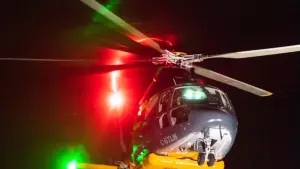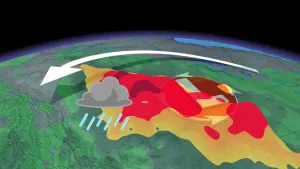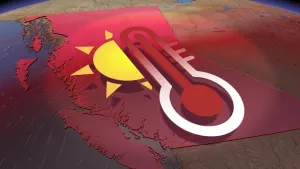
NASA's Curiosity rover celebrates seven years of science on Mars
What's Up In Space? Curiosity celebrates 7 years on Mars, Canadian students run a trial Moon mission, and a nearby alien world is a promising candidate to host life.
Seven years ago, on August 5, 2012, NASA's car-sized, nuclear-powered robot rover, the Mars Science Laboratory, better known as Curiosity, touched down on the Red Planet.
To mark this 'landingversary', scientists with NASA's Jet Propulsion Laboratory highlighted some of the most recent findings the rover, and provided us with a spectacular 360 degree view of Curiosity's current surroundings.
One of Curiosity's most recent science targets is a large rock composed of multiple individual layers of sediment, which the science team named "Strathdon".
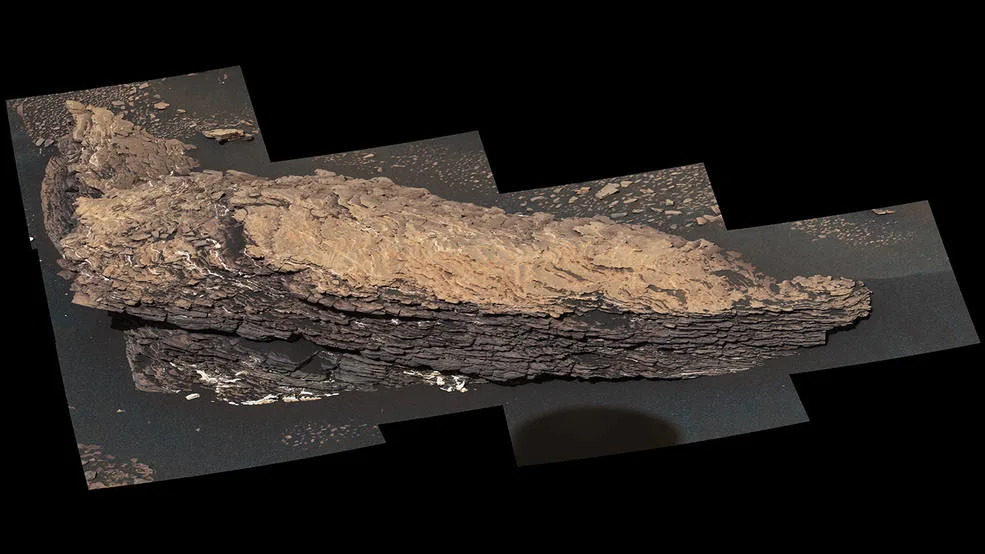
This mosaic of images shows "Strathdon" - a boulder-sized rock made up of many complex layers. These images were taken by Curiosity's Mast Camera, or Mastcam, on July 9, 2019. Credit: NASA/JPL-Caltech/MSSS

This mosaic focuses in on the Strathdon's layers of sediment, using the Mars Hand Lens Imager (MAHLI) camera attached to Curiosity's arm. The individual images in the mosaic were taken on July 10, 2019. Credit: NASA/JPL-Caltech/MSSS
According to NASA, Strathdon's sediment layers have "hardened into a brittle, wavy heap," and the structure of the layers suggest that the lake that once existed at the bottom of Gale Crater was a more dynamic environment than other regions of the crater have suggested.
"We're seeing an evolution in the ancient lake environment recorded in these rocks," said Valerie Fox of Caltech, who is one of the co-leads of Curiosity's investigation of the clay minerals in Gale Crater. "It wasn't just a static lake. It's helping us move from a simplistic view of Mars going from wet to dry. Instead of a linear process, the history of water was more complicated."
Watch below to see a 360 degree view of Curiosity's environment on Mars
CANMOON MISSION TRAINS STUDENTS FOR LUNAR EXPLORATION
With plans in the works for numerous robotic and human missions to the Moon in the years ahead, faculty and students at Western University's Centre for Planetary Science and Exploration (CPSX), in London, Ont., are wasting no time in their preparations for Canada's involvement in those missions.
From August 5-16, 2019, CPSX is running a 'mock' lunar rover mission, known as CanMoon.
In the tradition of previous CanMars missions, the participants in this project range all the way from undergraduate students to professors, and they seek to recreate how a real rover team operates.
While mission control is in a classroom on the Western Univerity campus rather than at one of NASA's centres, and the rover is in a remote location in Lanzarote, Spain, rather than the actual Moon, the processes of planning and executing the rover operations, and the examining of the science behind the results, is effectively the same.
Follow along with the mission on the CPSX CanMoon website.
NEARBY SUPER-EARTH COULD BE TEEMING WITH LIFE
NASA's new planet hunter, TESS - the Transiting Exoplanet Survey Satellite - has been busy scanning the nearest stars for signs of rocky, Earth-like planets, and it may have lead astronomers to a very special case.
Roughly 31 light years away, in the constellation Hydra, there is small red dwarf star named GJ 357. Earlier this year, TESS began seeing tell-tail dips in the star's brightness that indicated the presence of a planet orbiting around it.
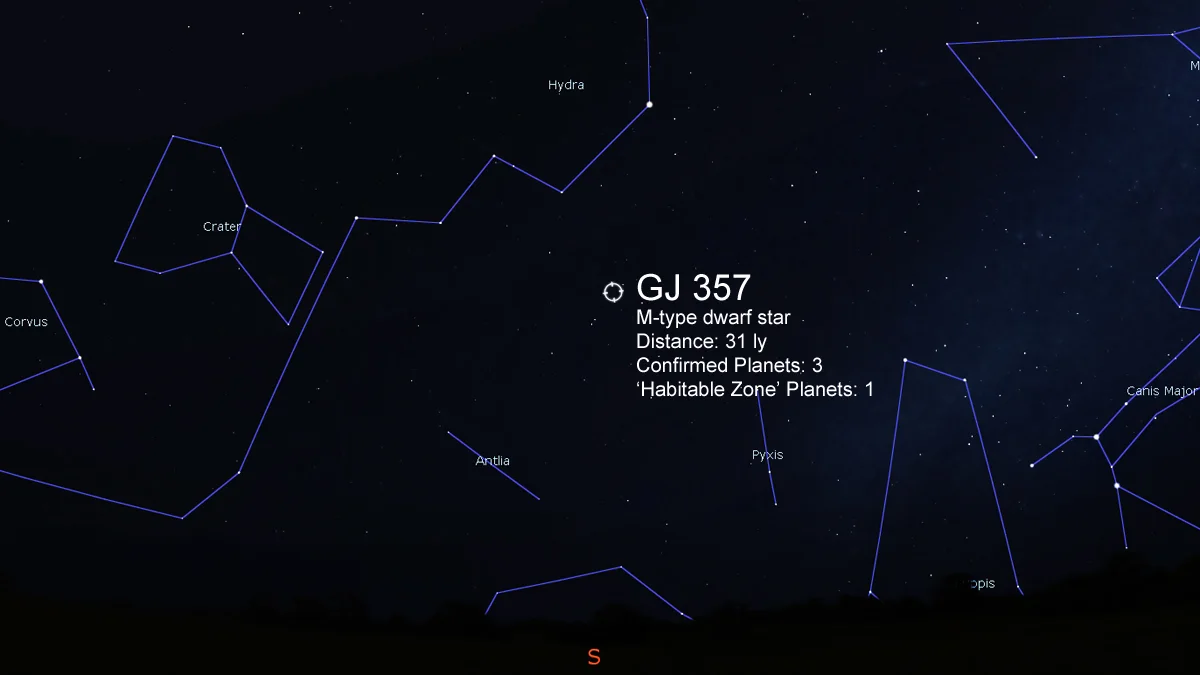
A planetarium view of GJ 357's location in the sky, near the constellation Hydra. From Canada, this star is only visible in the night sky during the months of October through May. Credit: Stellarium/Scott Sutherland
TESS's observations only showed evidence of one planet, GJ 357b, a hot world a bit larger than Earth, with an average surface temperature of about 250°C, but astronomers confirming this exoplanet using ground-based telescopes actually found two more planets in the process.
One of those planets is quite remarkable.
While all three circle very closely around their parent star (well within the orbit of Mercury, when compared to our solar system), and the inner two planets, GJ 357b and GJ 357c, have temperatures that are well beyond the tolerances for life as we know it, GJ 357d is special.
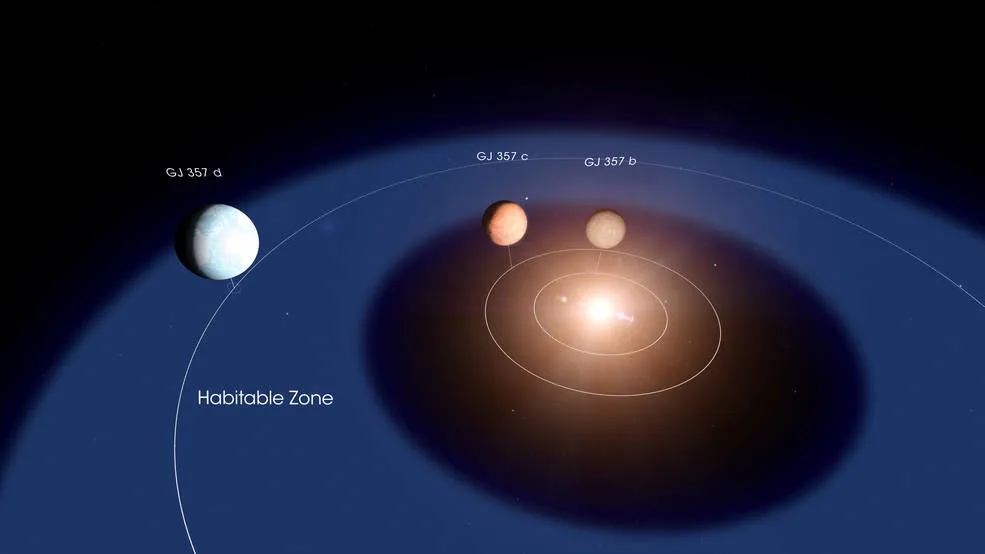
An artist conception drawing of the GJ 357 planetary system, including GJ 357d, which appears to orbit within the star's 'habitable zone'. Credit: NASA's Goddard Space Flight Center/Chris Smith
This 'super-Earth' planet, estimated at being around six times the mass of Earth, is far enough from its star that it could support liquid water on its surface.
"GJ 357 d is located within the outer edge of its star's habitable zone, where it receives about the same amount of stellar energy from its star as Mars does from the Sun," study co-author Diana Kossakowski, from the Max Planck Institute for Astronomy, told NASA. "If the planet has a dense atmosphere, which will take future studies to determine, it could trap enough heat to warm the planet and allow liquid water on its surface."
As far as we can tell, Mars, being a small rocky planet, cooled fairly quickly, and as its interior cooled enough to solidify, this shut down the planet's magnetic field. This exposed its atmosphere to being stripped away by the solar wind, which turned it into the apparently lifeless rock we see today.
A larger planet, however, would cool much slower, and thus be able to sustain a magnetic field longer (if it had one to start), and its gravity would hold on to a much thicker atmosphere. Therefore, if conditions are right on GJ 357d - it is a rocky planet, with a planetary magnetic field and a thick protective atmospehre - it's possible that it could sustain a much more habitable enviroment.
Now, there's no telling exactly what this planet is like, though. All we can know for sure, at the moment, is its mass and how long it takes to orbit the star (thus how far from the star it is).
It could be an airless rock, or it could be a small ice giant planet like Neptune, or it could be something unlike anything we've seen before. There's a chance, though, that it could be a world favourable to life.
Sources: NASA | WesternU/CPSX | NASA







